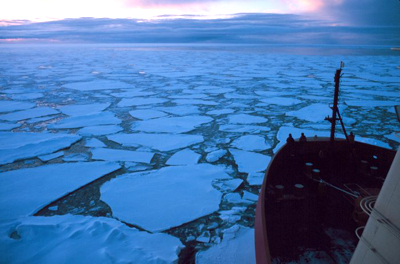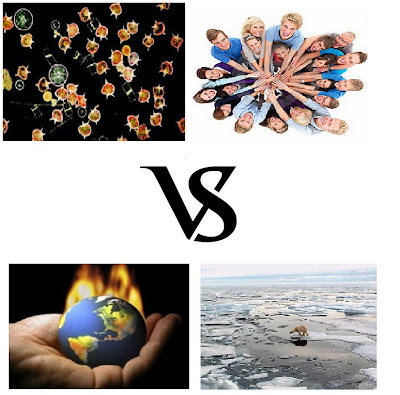http://www.sciencedaily.com/releases/2011/10/111004132718.htm

INTRODUCTION
Climate Change. It is one of the most prominent issues of the 21st century and has been a topic which has and continues to pose much controversy with today's scientific community. Bringing up an endless universal discussion that has baffled countless scientists and public officials, there have definitely been numerous theories and opinions formulated to explain the drastically changing climates of our planet. However, there is no question that the daily interactions of humans have definitely made a significant contribution to this whole worldwide phenomena. Through the constant evolution of humans and our great dependence on the resources of the Earth's natural environments, it has been generalized that we are greatly responsible not only for the contribution towards the Greenhouse Effect (our harmful carbon dioxide emissions entrapping solar radiation in our stratospheres which ultimately affects climate), but also for negatively impacting many stable ecosystems through our actions including the polar oceans, to name one.
SUMMARY OF ARTICLE
This intriguing article from ScienceDaily speaks about certain species who are most greatly affected by the melting ice caps in the polar oceans. These include the already endangered polar bear, and now even threatens India's iconic tigers and elephants (ScienceDaily). This article then continues on to discuss the impending threat of rising sea levels over the next 2-3 decades due to the melting of the Greenland Ice Cap (from the warming of the arctic) and how it will ultimately lead to even more severe flooding in coastal nations such as Bangladesh (who are already vulnerable to flooding, monsoons, and hurricanes). Researchers of different disciplines ranging from oceonographers to engineers who also hail from different nations and institutions such as Chile, India, Germany, the Norwegian Polar Institute, the University of Bergen, and the NTNU; have all collaborated to formulate a research plan to deal with climate change and to hypothesize its ability to further alter the physical and chemical processes that control polar oceans. They studied many specific effects of climate change on the polar oceans including the changing levels of ocean acidification and the disruption of biogeochemical cycles and food webs. The study came to a conclusion that the because climate change is causing the oceans to warm, areas with no oxygen in the water are further expanding; potentially affecting fisheries as well (ScienceDaily).

Keeping in mind the understanding of how carbon emissions are significant contributors to overall climate change as well as the relationship between the warming of the ocean and its abilty to become a carbon sink, scientists had believed that this was the key to limiting global warming. Scientists believed the by artificially engineering phytoplankton, through a process called geoengineering, they could substantially remove up to 1 gigatonne of carbon from the atmosphere per year due to the phytoplankton acting as carbon sinks during their processes of photosynthesis. This solution however also brought about many obstacles which included how phytoplankton needed iron to grow properly and how they were constantly preyed on by other species of plankton, namely zooplankton. This prompted many of the researchers to consider the fertilization of ocean areas with iron for the proper growth of phytoplankton as well as including concentrations of silica to form a protective glossy coating around the phytoplankton to protect them from the zooplankton. Unfortunately, the fertilization of the polar oceans with these sources could possibly pose many negative effects on other species such as harming the natural growth of krill and the health of coral reefs and kelp beds. In short, these changes have the potential to affect climate change positively but at the expense of destroying the once balanced ecosystem of the polar oceans (i.e. the introduction of harmful substances, affected food webs, destroyed habitats, etc).
ANALYSIS: ACCURACY,CREDIBILITY, and BIAS
Accuracy
Examining the many claims made in this article, I found that it had been quite accurate in terms of exploiting several of the plausible adverse effects of continued climate change on the polar oceans. With the polar ice caps having already shrunk 20 percent in area since 1979, around 9 percent per decade; it is assumed that the polar ice caps could be completely melted away by the next century if no changes are made (NRDC: Global Warming Puts the Arctic on Thin Ice). This justifies the assumption regarding that sea level rise would be inevitable over the next 2-3 decades, eventually resulting in flooding and other natural disruptions that could potentially destroy many ecosystems and living things.
 |
| Since 1979, the size of the summer polar ice cap has shrunk more than 20 percent. (Illustration from NASA) |
In regards to the geoengineering of phytoplankton as a means of counteracting the accumulation of excess carbon emissions in the atmosphere, the claims had also been quite plausible due to the fact that phytoplankton is a well-acknowledged carbon sink found in marine ecosytems with great potential to aid in the retaliation against climate change. With this in mind however, the warming of oceans has been hindering its natural growth of these organisms ultimately creating a positive feedback loop in which there is less phytoplankton to counter the rising temperatures due to the amount of carbon in the atmosphere in the first place. After conducting further research on phytoplankton and its vital role in its respective ecosystem, the claims regarding the fertilization of polar oceans with iron to increase the artificial production of phytoplankton are justified due to the fact that they need the iron that they are being deprived of (from warming polar oceans) in order to blossom and function properly (National Geographic).
As we can see, the findings of the article had presented themseleves with much evidence, introducing ideas I would have never considered that were backed up by many statistics and figures. As impressive as this article was, I greatly praised this article's mention of how many researchers are aware that the general knowledge of climate change is not sufficient enough to truly understand its many possible outcomes in the future. Also while the hypotheses of a climate change solution involving plankton in polar oceans may seem quite conceivable, one must understand how many factors there are to consider and how it may not be an effective long-term solution for carbon sequestration.
Credibility
With the article's main objective to inform its readers of the issues regarding climate change and its effects on the polar oceans, I found that the many presitigious institutes (Norwegian Polar Institute, University of Bergen, NTNU, LOHAFEX, and India's National Institute of Oceanography) mentioned in the article as well as their respective ideas and contributions to the study of the polar oceans were extremely legitimate and credible. As mentioned before, their understanding of the issues and their offered solutions had certainly been plausible and can be further supported by the research from other credible and even more renowed institutions such as NASA, NRDC, and National Geographic.
Bias
With Climate Change being such a controversial topic, it is quite undestandable as to why this entire conspriracy would seem one-sided and deemed negative in the eyes of the entire world. However, keeping in mind the fact that global warming is a result of an accumulation of natural changes as well as the result of humanity's basic needs to consume resources; we must understand that our contribution to climate change is inevitable and that we have no one to blame but ourselves for the destruction that we are causing to our planet. While it is an inconvenient truth to realize that our survival comes at the expense of other living things, we must truly strive to change our ways and find solutions that wouldn't have to compromise the well being of not only the polar oceans, but for all other ecosystems.
CONCLUSION/COMMENTARY
In conclusion, this article had definitely shed light on both the negative and positive impacts of humans on the diversity of living things. I had never truly realized how every action that us humans could make had ultimately resulted in affecting countless ecosystems that we wouldn't even be aware of harming (with the polar oceans only being one specific example). While this article had also showcased how humans are also willing to protect or at least reverse the harm we've already inflicted on the the planet, we are also endangering the delicate balance of nature's ecosystems by experimenting with different solutions. Either way, we are always affecting the processes of nature. While the Climate Change conspiracy may upbring numerous discussions regarding effectiveness and how relatively ethical our solutions are in respect with the diversity of living things, we can come to a conclusion that one of the most effective ways we can conserve the polar oceans and its endangered species (such as the polar bears, tigers, and elephants) is to reduce our dependence on natural resources to reduce our carbon emissions. While some of the damage has already been done, it is not too late too change our ways for the better of the planet. Fighting climate change can even take place through simple actions such as taking public transit, consuming less electricity, and purchasing local products. These options may seem to pose small and insignificant changes, but if we could merely inspire others to do the same and to start making simple changes in our lifestyles that we wouldn't even notice; we could definitely make lasting impacts on the future of the polar oceans. Like the phytoplankton solution, if many of us banded together in an united attempt to reduce carbon emissions; we to can also remove or at least prevent a huge amount of carbon from further warming up the planet. We must start changing our self-destructive ways before the polar oceans and many other ecosystems are eventually destroyed due by our carelessness.
WORKS CITED
"NRDC: Global Warming Puts the Arctic on Thin Ice." Natural Resources Defense Council – The Earth’s Best Defense | NRDC. Natural Resources Defense Council, 22 Nov. 2005. Web. 09 Oct. 2011. http://www.nrdc.org/globalwarming/qthinice.asp.
"Polar Oceans in Transition." Science Daily: News & Articles in Science, Health, Environment & Technology. Science Daily, 04 Oct. 2011. Web. 05 Oct. 2011. http://www.sciencedaily.com/releases/2011/10/111004132718.htm.
Roach, John. "Can Iron-Enriched Oceans Thwart Global Warming?" Daily Nature and Science News and Headlines | National Geographic News. National Geographic, 09 June 2004. Web. 09 Oct. 2011. http://news.nationalgeographic.com/news/2004/06/0609_040609_carbonsink.html.

